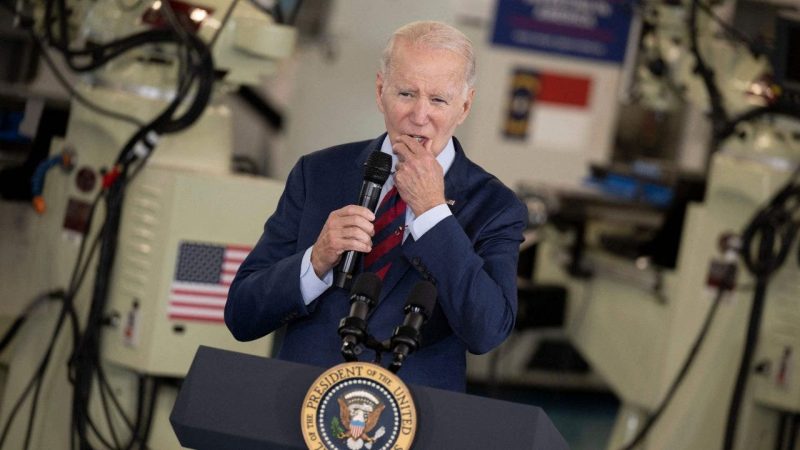
Biden regulations have cost Americans almost $10,000 per household: study
The Biden administration’s burdensome regulations have cost Americans about $10,000 per household, according to a new report, which noted that figure could skyrocket if President Biden is re-elected in 2024 and serves another four years.
Casey Mulligan, a professor of economics at the University of Chicago, compares the regulatory records of President Biden and former Presidents Donald Trump and Barack Obama in a new study published by the Committee to Unleash Prosperity.
As of the end of last year, according to the study, the Biden administration imposed new regulatory costs on American households and businesses at a pace that is surpassing that of the Obama administration during a comparable time period. Specifically, Mulligan writes that the Biden administration has so far been adding regulatory costs at a rate of $617 billion per year of rulemaking, not counting regulatory costs created by statutes and other non-rule regulatory actions.
Mulligan calculates that the added costs of these Biden-era rules finalized in 2021 and 2022 — including both their current and expected future costs — amount to about $9,600 per household. These costs are spread over time rather than concentrated in the first year that the rules take effect — and could spike significantly if Biden is re-elected.
If rulemaking and regulatory costs continue to accelerate at the same rate as they did during the Obama administration, the report states, ‘[T]he result after eight years [under Biden] would be a cumulative $7 trillion, which is almost $60,000 per household.’
Still, Biden has fewer regulations per year than Obama and Trump in almost every category, according to the report. However, the current administration has implemented some especially costly regulations, such as actions on student loans and vaccine mandates.
Overall, automobile fuel economy and emissions standards account for a third of the total regulatory costs, with health, labor, telecommunications and consumer finance regulations also comprising a significant chunk.
Unlike Biden, Trump oversaw large-scale deregulation, as the report notes.
‘The Trump administration’s agencies through four years reduced regulatory costs by almost $11,000 per household in present value,’ according to Mulligan, who notes that figure doesn’t include Operation Warp Speed to produce a COVID vaccine. ‘On an annual basis, President Trump was on net reducing regulatory costs (more than $300 billion per year of rulemaking) almost as fast as Presidents Obama and Biden were creating them ($600 billion per year of rulemaking).’
Unlike Obama, who Mulligan notes ‘had virtually no deregulation in his first two years,’ Biden has already implemented meaningful deregulations. However, on net, Trump’s deregulation was more far-reaching.
‘President Trump showed that regulatory costs can be subtracted rather than perpetually added,’ the report states. ‘Four years of President Trump reduced regulatory costs by about $11,000 per household. Eight years would have saved a total of more than $21,000, which is a gap of $61,000 to $80,000 from the Biden trajectory.’
Mulligan describes his report as the first ‘to comprehensively quantify the costs missing from agency cost assessments,’ explaining that several studies have shown government agencies employ poor cost assessments and detailing how these agencies often impose large opportunity and resource costs without acknowledging them.
‘However, even if we ignore the large number of regulatory costs missing from the agency estimates, they show a meaningful gap too,’ Mulligan writes. ‘Eight years of President Trump would add only $561 to the average household’s cost (agency estimate), whereas eight years of Biden staying 15% ahead of the Obama administration would cost households almost $11,000 each on average. The stagnation of economic growth, declining worker productivity, and wages that fail to keep up with inflation could well be linked to the resurgence of regulatory burdens.’
The new report comes as Biden seeks to tout his economic policies heading into the 2024 presidential campaign.
On Wednesday, Biden delivered a speech in Chicago in which he condemned ‘trickle-down economics’ and promoted so-called ‘Bidenomics,’ arguing he’s steering the economy in the right direction with positive growth and low unemployment.
‘The economy that grows the economy from the middle out and the bottom up, instead of just the top down — when that happens, everyone does well,’ Biden said in a nearly 40-minute address. ‘This vision is a fundamental break from the economic theory that has failed the middle class for decades now. It’s called trickle-down economics.’
Economists disputed the notion that ‘Bidenomics’ benefits all Americans, telling Fox News Digital that massive spending and historically high inflation have marked the president’s economic policies since he entered office.
Meanwhile, a White House memo this week touted Biden’s economic agenda and accomplishments, which includes job growth, low unemployment and a major infrastructure plan.
‘Bidenomics is rooted in the simple idea that we need to grow the economy from the middle out and the bottom up—not the top down,’ the memo stated.
Biden tweeted Tuesday that he created more jobs in two years than previous administrations did in the entirety of their first terms — a point dismissed by critics as misleading due to lost jobs during the coronavirus pandemic.
Despite Biden’s confident tone, Americans have very little confidence in his ability to steer the U.S. economy, according to recent polling. As of late May, some 83% of voters say the economy is in only fair or poor shape. That stat is worse by 14 points than shortly after Biden entered office in April 2021, when just 69% thought the same. Critically, just 20% of Americans say they believe Biden’s policies are helping them.
The White House didn’t respond to a request for comment for this story.
